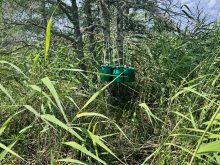A variety of tools are required to meet landowner needs and protect
wildlife habitat.
A conservation easement, or CE, is one such tool.
A CE is a voluntary, legally recorded agreement between a willing
landowner and a qualified conservation organization, such as Ducks
Unlimited Canada.
In exchange for relinquishing certain rights, which will ultimately
result in long-term protection of specified wildlife habitat, a
landowner who donates a CE may be eligible for tax benefits through the
Read Also

Government, industry seek canola tariff resolution
Governments and industry continue to discuss how best to deal with Chinese tariffs on Canadian agricultural products, particularly canola.
Canada Customs and Revenue Agency. A CE is a flexible document in which
the landowner keeps title to the property, access control and selling
rights. Conditions of the agreement will apply to the land as long as
the document is valid.
Ducks Unlimited, with assistance from the University of Manitoba,
recently unveiled its Paid Conservation Easement Project, which is
being carried out in the Torlea Plains region of Alberta.
In this and three other locations across the Prairies, Ducks Unlimited
wants to reward landowners for conserving habitats and listen to
opinions regarding fair compensation levels for perpetual CEs.
CEs are site specific and may be designed so that only the important
wildlife habitat portion of a particular property is protected. The
non-habitat portion may then be free for limited development subject to
specified CE clauses. This can only be determined by the physical
characteristics of each particular property.
In most cases Ducks Unlimited is mainly interested in protecting
designated wetlands from drainage, and adjacent nest cover habitat from
adverse development. Easement clauses reflect the restrictions
necessary to protect this habitat.
The following scenario illustrates how a CE could work.
The Smiths own a quarter section of farm property with a 30-acre marsh
in one corner. Next to the water is a 40-acre grassland area that
provides upland cover for waterfowl and habitat for other wildlife. The
Smiths would like to see this portion of the property remain a haven
for wildlife for generations to come.
Ducks Unlimited (the grantee) prepares a draft CE for the Smiths (the
grantor), complete with a physical location of the 70 acres of wetland
and adjacent grassland habitat.
The CE contains clauses that outline restrictions placed upon the
identified habitat lands. Restrictions might involve drainage,
dredging, dumping of materials, unauthorized removal of grass cover and
other actions that would affect the intent of the easement.
The CE would also outline what is permitted on these lands. One example
might be grazing.
A “baseline ecological inventory” of the CE area is done to identify
the property’s unique ecological features. This inventory helps clarify
the purpose of the CE, sets appropriate boundaries and restrictions,
and assists with future monitoring for compliance purposes.
A third-party appraisal is completed to determine the fair market value
of the donated CE for income tax purposes. This looks at the difference
in the value of the land before the CE, and with the CE
restrictions in place.
It is in the best interest of both parties to determine the fair value
of the “gift” for tax purposes. The landowner is also encouraged to
seek legal and tax advice for determining the personal financial impact
of granting the CE.
Once the agreement terms are final, appropriate notification,
signatures and land title registration procedures are carried out.
For further information on conservation easements, contact your nearest
DUC office, call 800-665-DUCK (665-3925) or visit the website at
www.ducks.ca.
Those in the Torlea Plains region can contact Les Wetter at
403-342-1314.
















